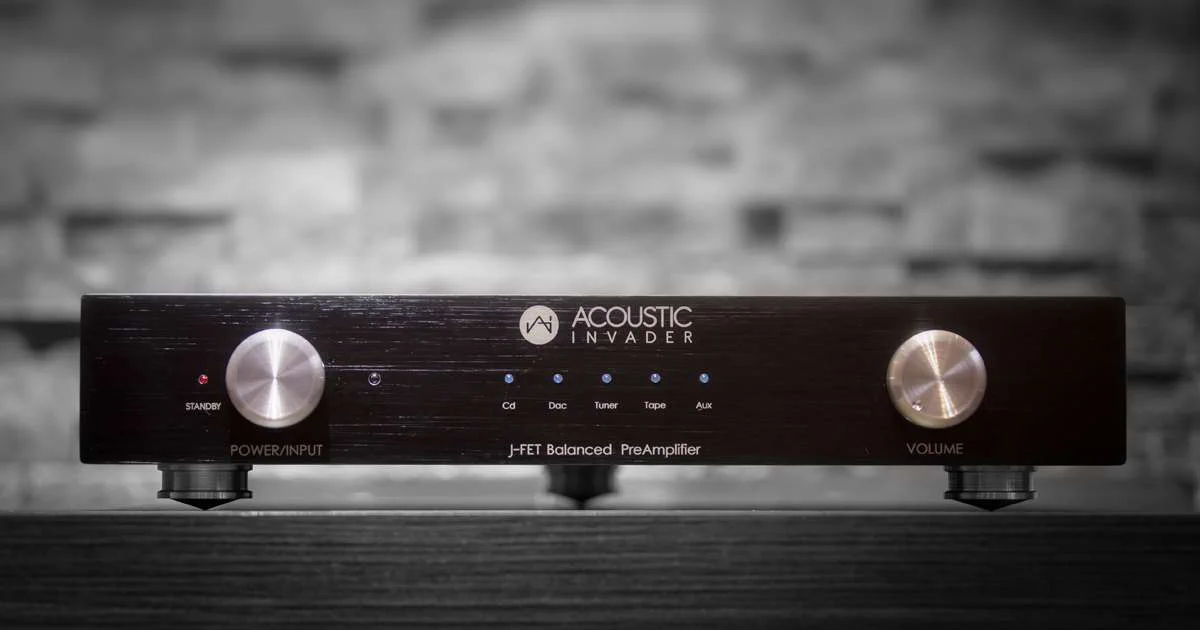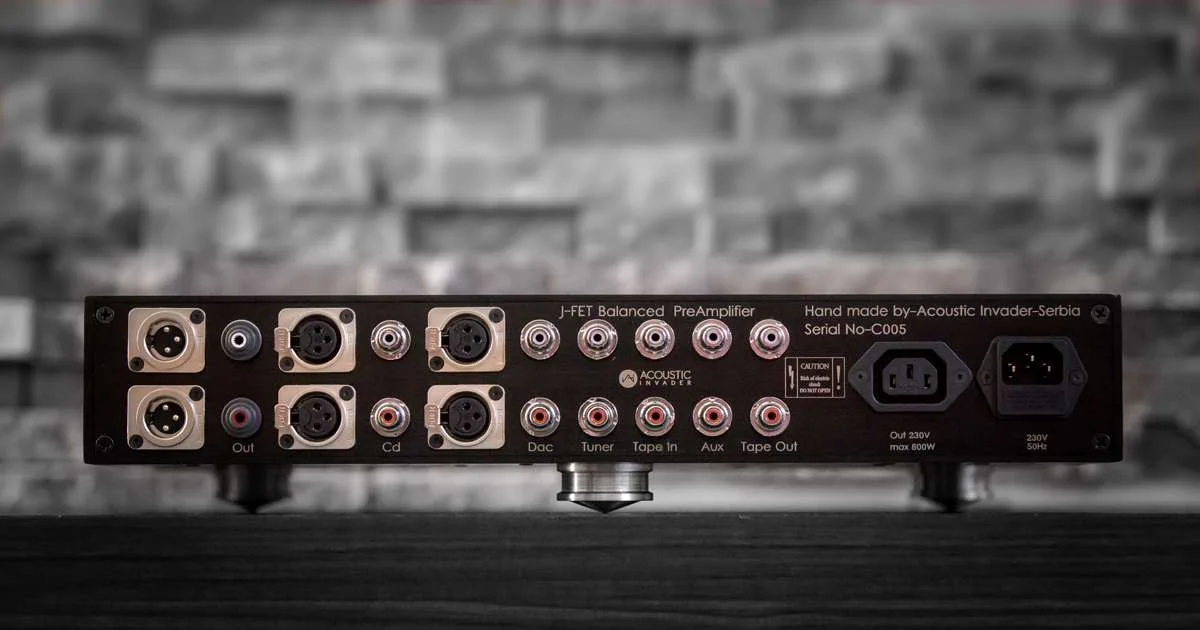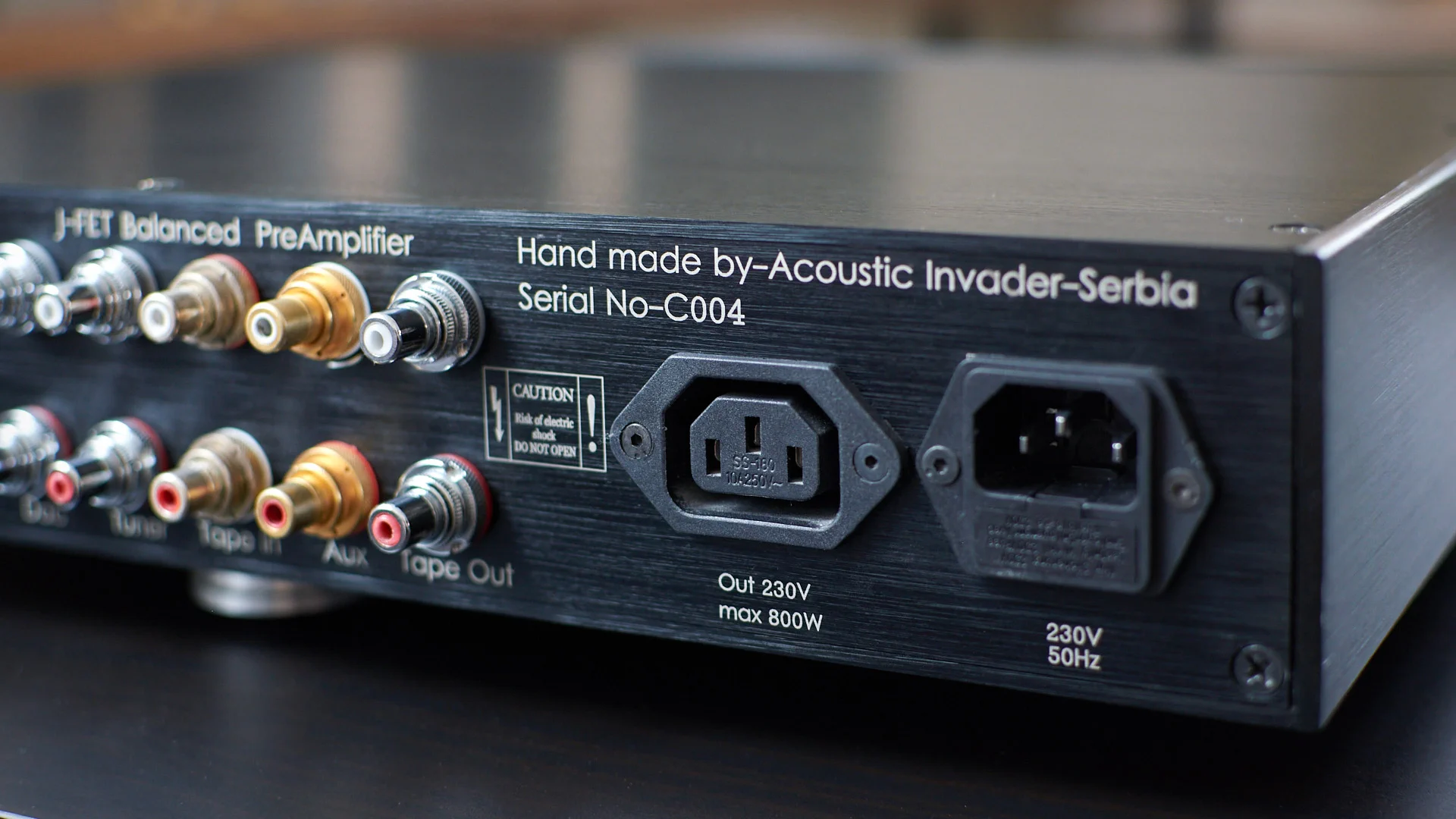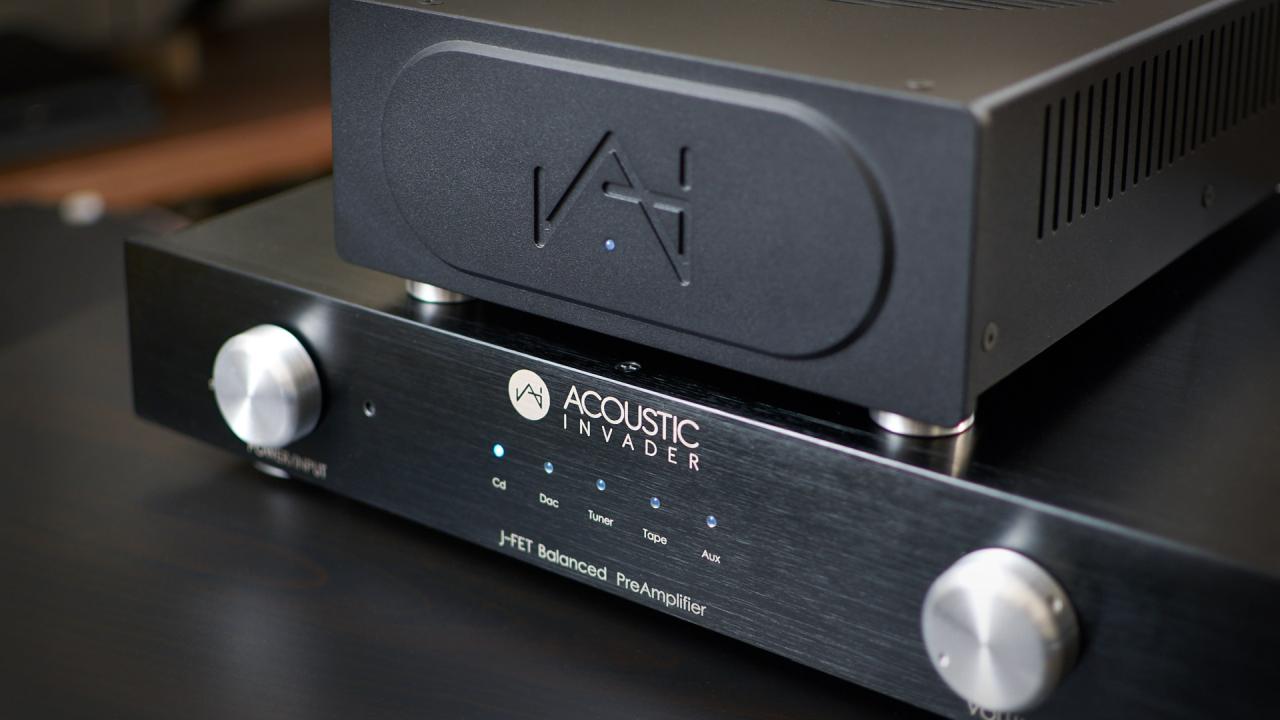I have never heard about the Acoustic Invader – is probably what you’re thinking right now. That is quite expected because we are talking about a small brand coming from Serbia that sells directly to customers. Even I didn’t know much about it up until recently, and I actually live here. What can I say in my defense, small manufacturers are so easily overseen in such a crowded market where big brands bomb us with advertisements through established magazines and websites. But now I feel so glad that this particular brand was brought to my attention. Stay with me and find out why, because this will not be your regular “good for the money” review. Oh no, this is something else.
Preamp Features
Starting with the preamp, it is a nice-looking device made fully of brushed aluminium. Two knobs on the front are also aluminium made and the right one used for volume control is motorized. Take a look at the back of the unit and you’ll find that connectivity is rich. There are five RCA inputs and two balanced XLRs. Output can again be single-ended over RCA or balanced over XLR. At the bottom, we find three aluminium feet that end with a conical shape. These are not sharp enough to pierce your HiFi rack but I would suggest using some kind of footers anyway to make them less slippery.
The preamp is based on J-Fet technology working in class A which is not something you’ll commonly find in a preamp. Constructor Goran says this topology gets some really desirable tonal character that we like in a good tube preamp, such as musicality and bassline agility while keeping many good traits of transistor-based solutions such as speed and impact. If that’s really the case I’ll tell you later in the Sound section. The design is fully balanced, and each channel gets its own separate power supply hence the two toroidal transformers. But Goran didn’t stop there, he even implemented a completely independent third power supply (small red transformer on the board) for LEDs, motorized pot, etc. This means that the signal path gets the purest untainted power source. In the output stage, we can find high-quality Amp-ohm polypropylene capacitors, the kind that you are hardly going to find in commercial devices under five grand. To top all of this, special attention is given to the internal wiring that is sourced from audio cable manufacturers. You won’t find cheap PVC hook wire on the signal path here.



Power Amp Features
The power amplifier is based around a well-known ICEpower 1200AS2 class D module. This is regarded to be one of the best and certainly one of the most powerful class D modules on the market with 620 Watts into 8 Ohms. To spice it up a bit, Goran mounted it inside of a sturdy aluminium box, but unlike most of the ICEpower implementations, the casing itself is not used as a sole means of dissipating power. A dedicated aluminium heatsink is used for better cooling which provides more stable thermal behavior and load handling. Once again, high-quality cabling is used, WireWorld and Van den Hul were mentioned. The same kind of attention is given to the external connectors, so we are treated with NextGen WBT speaker binding posts, and IeGo power inlet. I know some won’t care about all of this, but in my experience, those details are what make a difference between a good and a great product. Acoustic Invader designer seems to agree and is eager to create only great ones.
Interesting to note is that there is a power switch on the back of the amplifier, but you should leave that one ON during normal use. The power amp will go to sleep by itself if a signal is not detected for 15 minutes. It will wake up again when the signal from a preamp is detected. During several months of use, this worked flawlessly in my own setup.


Sound of the pair
At the moment of receiving this preamp and amp combo, my daily driver was Hegel H90 integrated preamp. Denafrips Ares II DAC and Pi2Design Pi2AES digital streamer are feeding the amplification that is driving a good old KEF LS50s. To add a little bit of authority, a REL T5/x subwoofer has joined the team.
The first evening I connected Acoustic Invader in my setup, I was treated with a very lively and detailed sound that lacked warmth. I was thinking to myself – this might be a typical Class D affair. I left the devices powered on and went to sleep. The next day I put on some casual background music, went on to make a cup of coffee, and returned for a take two. The soundstage was big as a house and the leading vocals were so palpable that I felt I could stand up and touch them. I browsed through several songs and that feeling of big and present sound didn’t go away. I immediately disconnected the Acoustic Invader combo and put my good old Hegel H90 back in. Yes, that was that natural and smooth Hegel sound that I knew, with a deep and spacious soundstage, but the commanding presence and immense soundstage that stretched over the boundaries of the speakers were not there. Dynamically speaking, H90 sounds more sedated too. In a course of three songs, I started to lose interest and craved to hear that Acoustic Invader sound again, so I did. Yes, there was it – a ridiculously big soundstage projecting leading vocals and instruments much more ahead while keeping background ones as deep as Hegel. It feels like somebody has just inflated that soundstage balloon and made me feel like I am sitting just in front of it instead of looking from afar. Play something mastered that way purposely such as Mumbo Jumbo by Brent Lewis and you’re going to feel that sound is all over the room.
The more I’ve listened to it, the more qualities piled upon each other. The layering inside of the big soundstage is great and each tone has its own place, as well as plenty of empty room around it. More so than I’ve ever witnessed in my system before. PRaT (Pacing, Rhythm, and Timing) is exceptional and Acoustic Invader pulls you into the song, making you tap your feet. No matter how hard I’ve tried I couldn’t get through the Boogie Shred by Mike Dawes without nodding my head to the rhythm. The way this preamp and amp combo handles the bassline is amazing. There’s plenty of grunt and authority, but even more importantly there is such agility and natural flow to the bassline that makes most other amps sound like blunt tools. Rarely have I ever in my HiFi journey heard a bassline with this much weight that moves and takes turns so gracefully.
What’s the catch?
Now the logical question would probably be – is that lively and dynamic sound coming at the expanse of musicality? I’m so happy to say – no. Tonally speaking, Acoustic Invader has a full sonic signature. I already covered that otherworldly full and agile bassline so let us move to the midrange. Vocals sound as juicy and lush as you could ever want, and this extends to basically every instrument. The body of a tone will always be a priority over sharpening the edges. A great sense of palpability and three-dimensionality stems from this. I play this fantastic duo of singers performing The Highwayman and their voices, as well as their guitars, feel lifelike in my room – husky and full in all the right amounts. The only part of the presentation that Acoustic Invader does just very good and not sublime is the highest register. It is squicky clean and without any sort of grain you might find with lesser devices and many class D based amps. So what’s the problem then, you might ask. Well, there is none really, it’s just that this is not the region you will notice most of the time or fall in love with. It’s clean and present but not prominent, it’s informative but not exciting, and there is no shimmer to it or any kind of holographic effect. But make no mistake, highs are not rolled off or dark sounding either, those high-frequency details are all present and ready to support and outline the sublime midrange and bassline, without getting attention to themselves.
I only later learned that the preamp needs some time to warm up when first connected because the class A topology takes some time to achieve a stable working temperature. This caused a slight lack of warmth to the sound the first time around so don’t judge it harshly upon arrival. Once it’s up and running, however, you’ll quickly forget all about that initial impression.

Comparisons
This section will not always be apples to apples because I’m not a big HiFi publisher having many preamps and amps readily available on hand. Some of those will be integrated amplifiers, but given their price I consider this to be a more than fair comparison.
Hegel H190 is a powerful integrated solution with digital inputs that goes for 3500 euros here and it is around $4000 in the US. This means that both Acoustic Invader components and a very decent DAC can be purchased for the same amount of money. In this comparison, I’ve kept to Hegel’s analog section only and compared it to the Ai. In terms of overall tonality, they are actually more alike than they are different – it’s a neutral and smooth sound without harsh edges or grain. Being much more powerful (2x150W) than my own H90 (2x60W), this Hegel proved to be a much more capable competitor. It packs as much slam and bass authority, but Acoustic Invader has a more agile and tuneful bassline, bending any bass note to its will with more ease and grace. Spatially speaking, Hegel creates a big and laid-back soundstage where Acoustic Invader stretches it more toward the listener and creates more empty space around the instruments. Ai is also capable of creating fuller individual tones that feel more palpable in space. Add better PRaT to it and Acoustic Invader feels more engaging and lifelike to my ears.
NAD M32 is another all-in-one solution that used to retail for ~4000€ until it was discontinued in favor of the newer M33 which is yet another grand pricier. Again, only the analog section was compared to Ai. NAD M32 is a mighty quick and resolving sounding amp but that comes with slightly analytical tonality and grain in the midrange that gives a slightly digital feel to its sound. Acoustic Invader offers an equally agile bassline that is also weightier and has more PRaT. Midrange again feels fuller, lusher, and smoother over Ai components, without even a hint of grain or a digital feel. All in all, M32 is quick, open, resolving, and airy… but Acoustic Invader is tonally richer and with a much more natural flow to my ears.
Schiit Freya+ preamp is a well-known “giant-killer” coming at $950 in US and 1050€ in Europe (I’ve never seen it being in stock here actually). Having it delivered directly from the US to my country costs around 1400€ in total, fully matching the price of the Ai preamp. The same statement about increased costs would be true if you order Acoustic Invader delivered to the US of course. Having these regional price differences in mind, let’s get to it.
In the bass section, Freya plus is weighty and authoritative but a bit slow on its feet, not as agile and tuneful as Ai preamp. But this is not your dark and syrupy sounding tube preamp, it has an edge and quite forward sound in the upper midrange. Ai has less byte with edges such as guitar string plucks, so it may sound less exciting at first glance but it offers a much fuller and richer lower midrange. Freya plus feels dry and rough in a direct comparison with Ai’s liquidy smooth presentation. Both male and female vocals can sound a bit spitty through Freya and tiring after some time. Spatially speaking, Freya offers the most spacious sound in its tube mode, but it still falls short of Ai’s big and bubble-like soundstage. PRaT is also better on Ai preamp.
I have both of these in my possession at the moment, I might still play with different tubes on Freya some more, but can’t see it closing this kind of gap that way. I feel that Ai preamp is a notch or two above it.
Conclusion
It has been some time since I’ve become aware of Acoustic Invader. Several audiophiles praised it highly on a local HiFi forum, some claimed that those components matched much pricier pieces of gear such as Classe separates and similar devices. Since those are utterly out of my financial reach, I can’t confirm nor deny such bold claims, but I can share a short story instead. After being contacted by the Acoustic Invader designer Goran (the purpose of the call was something else and not the Acoustic Invader gear), we talked a bit and he came off as a very nice and polite, even a humble person. Near the end of our conversation, he mentioned he produces HiFi gear and we agreed that I’ll try this preamp and power amp. I still remember him saying “if you happen to find those devices worthy enough to say a few words about them, that would be great”. Little did I know that from such a humble introduction these mighty good devices will come to my doorstep. A few weeks later, after realizing that several big brand products simply couldn’t compete sonically I contacted Acoustic Invader again and asked to buy these pre-owned units instead of returning them. Several months have passed since then and I still consider this one of my smartest purchases ever.
| ACOUSTIC INVADER PREAMP & POWER AMP – CHARACTERISTICS |
|
Preamplifier |






Really enjoy your reviews. I am very intrigued by the Acoustic Invader preamp. I currently have the Freya + with some nice Sylvania tubes, but am now very interested in trying the Freya S or the Acoustic Invader, as a possible replacement. I have sent them a couple of emails seeing if they will ship to the USA, no reply yet. Wonder if you ever heard the Freya S with Nexus? Even Jason Stoddard prefers the S to the + with tubes.
Hi. I never heard Freya S but I enjoyed Freya+ with Sylvania tubes. As for the Acoustic Invader, I belive they ship to the USA but its possible that Acoustic Invader designer Goran might be overwhelmed with inquaries so it’s just a delay in answering emails. Even more possible is that your email was falsly branded as sepam. I can message him to check his spam folder. I know I don’t do that regualrly enough. 🙂
Thanks Srboljub, Yes, I am now in communication with Goran, and have the latest brochure/price list. Appreciate your response, and again, I enjoy your video and written reviews!
Hi,
In your review you are also presenting the Fulcrum. I did a search on this model but can’t find anything.
Is this model discontinued, as there are still pictures on the hi-files.com site.
Regards,
Maarten M. vam der Linden
the Netherlands
It’s not discontinued but unfortunatly the official website is very out of date. I’m not sure why is that and when it will be updated. That said the Fulcrum preamp is a part of Acoustic Invader’s flagship line that includes a Lancer DAC too, and newly developed amplifier for biamping. Ufnortunatly it comes with a very flagship price of ~6000 euros. For most acurate pricing and info it’s best to contact Goran via mail acousticinvader@gmail.com
Hello Srboljub,
My name is Gabriel and I am following your YouTube channel for some time now. I would like to ask you a favour, an advice, your opinion regarding the AI preamplifier. In this very moment I am using a DMP A6 ME as a streamer/ DAC connected via XLR cables to my NAD C298 amplifier. I have that feeling of a missing link in the chain and maybe you could help pe with your opinion on how much do you think that adding the AI preamplifier will increase the overall sounding quality? 99% of my listening sessions are based on Tidal max streaming service in a 25 sqm acoustic treated room. From where I live here in Romania to Novi Sad are only 500 km and I have a plan to travel in order to get the preamp directly and have some Serbian traditional dinner 🙂. Could you please let me know your opinion? Thank you in advance.
Hi Gabriel. Thanks for following my videos and articles. You have a fine setup there but I do belive that there is a missing link. If you by any chance saw my DMP-A8 review, there was a section about the preamp there. Adding Ladder Bach improved deteil retrieval and soundstage noticeably. Acoustic Invader preamp is even better than Bach and it should definitely add not only deteils, but more importantly richer tone timbre and wider soundstage to your setup. I can’t join number to the scope of improvement but it’s not small by any means.
Hi Srboljub!
I’ve seen your DMP 8 review and there I’ve noticed the AI preamp. I’ve only need another confirmation for the AI as I was close to purchase the Topping 90Pre but now is sure I should make a trip to Novi Sad.
Thank you for your fast answer and detailed information!
Hello Srboljub, how timbre (bass, treble) regulation can be adjusted for Acoustic Invader (as I see, there is no possibility to do it in preamp? Thanks.
Hi Tomas, it can’t be adjusted since there are no tone controls onboard.